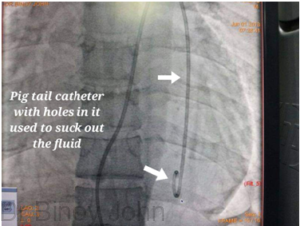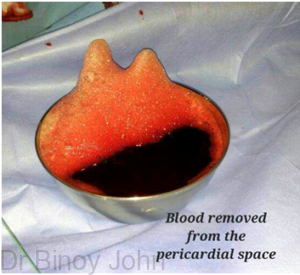What is the pericardium?
The heart is covered by a protective double membrane called the pericardium. It has two layers and is a balloon like fibro-elastic sac with the inner layer stuck to the heart, This sac formed with the outer layer is a potential space which normally contains only less than 50 ml of fluid just enough to provide lubrication.
What is a pericardial effusion and cardiac tamponade?
The normal amount of pericardial fluid in the pericardial sac is just less than 50 ml. However in certain diseases there can be accumulation of fluid which can exert pressure or weight on the heart and compressing the heart thus preventing the heart from expanding and the heart becomes smaller and smaller. When this happens sufficient blood is not able to enter the heart causing a pump failure. This condition is called Cardiac tamponade. Cardiac tamponadecan cause cardiac arrest and is a medical emergency and immediate removal of the fluid is necessary for survival.
This accumulation of the fluid can be rapid or slow. When it is rapid as with blunt or traumatic injuries to the chest or sometimes during angioplasties or cardiac procedures, very little fluid is sufficient to compress the heart as the elastic pericardium doesn’t get enough time to stretch and accommodate the increasing fluid volume.
When the accumulation is slow as with certain medical conditions like tuberculosis, cancers, kidney failure and hypothyroidism, the pericardium stretches slowly to accumulate large amounts of fluid even more than a litre before cardiac tamponade sets in.
What is the treatment for pericardial effusion?
Treating the primary medical condition like hypothyroidism, kidney failure is the primary treatment for pericardial effusion.
What is the treatment for cardiac tamponade?
Emergency removal of fluid from the pericardial sac is the treatment for pericardial effusion causing cardiac tamponade. This can be done percutaneously without surgical opening of the chest by an interventional cardiologist by a procedure called pericardiocentesis. But at times the blood or fluid around the heart can be rapidly re-accumulating when due to trauma or an interventional procedure which will need a surgical repair of the primary source of bleeding with an open surgery under general anaesthesia.
What is pericardiocentesis?
Pericardiocentesis is the procedure by which fluid is removed from the pericardial sac and thus relieving the fluid from compressing the heart, thus enabling effective relaxation and filling of the heart and thus reinstating the normal pumping function. The procedure is usually done under local anaesthesia.
The procedure involves local anaesthesia being given at the base of the xiphisternum. Then a needle is used to puncture into the pericardial space underechocardiographic and X-ray fluoroscopic guidance. (See image)

Once entry into pericardial space is attained, a wire is passed into the pericardial space. (See image)

Then over the wire a Pigtail catheter which has got holes on it is passed into the pericardial space. (See image)

Then a syringe is used to suck out maximum fluid. As soon as the fluid is removed the blood pressure of the patient improves. (See image)

The pigtail catheter is usually left for one to three days to suck out any more re-accumulating fluid. The fluid is send for investigation and treatment of the cause is focused on to prevent further accumulation of fluid.
Video:
The video shows pericardiocentesis being performed in a person who was suddenly wheeled in to the CICU with sudden breathing difficulty. Her BP was crashing. Echocardiogram revealed that there was a massive pericardial effusion. This fluid was causing the heart to be compressed into a ball by the pressure of the fluid inside the pericardial covering of the heart, so much so that the heart could not expand or fill anymore, a condition called Cardiac tamponade. This was an emergency situation and the patient could die in no time if the fluid was nor removed immediately. So, the patient was immediately shifted to the cath-lab and an emergencypericardiocentesis was performed and around 300 ml of blood stained fluid was removed. The patient was immediately relieved of her breathing difficulty and her BP improved. The tube was kept for another two days and another 120 ml was subsequently removed. The patient was discharged a couple of days later.
Expertise: Dr. Binoy John is an expert in pericardiocentesis and has saved many patients with the emergency performance of this procedure.






